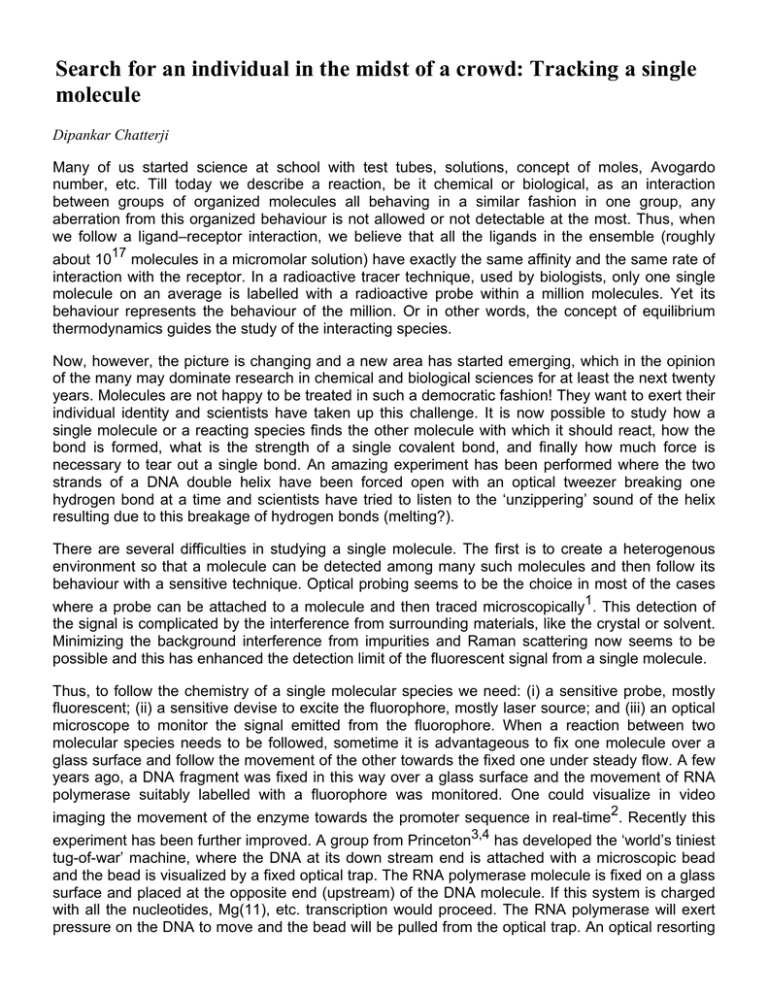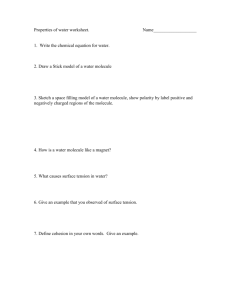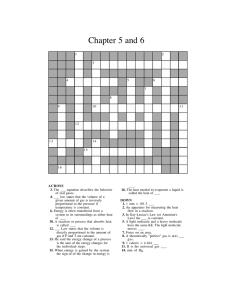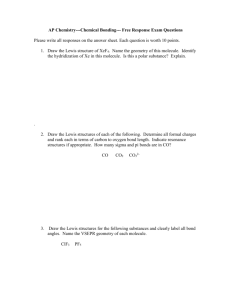Search for an individual in the midst of a crowd:... molecule
advertisement

Search for an individual in the midst of a crowd: Tracking a single molecule Dipankar Chatterji Many of us started science at school with test tubes, solutions, concept of moles, Avogardo number, etc. Till today we describe a reaction, be it chemical or biological, as an interaction between groups of organized molecules all behaving in a similar fashion in one group, any aberration from this organized behaviour is not allowed or not detectable at the most. Thus, when we follow a ligand–receptor interaction, we believe that all the ligands in the ensemble (roughly about 1017 molecules in a micromolar solution) have exactly the same affinity and the same rate of interaction with the receptor. In a radioactive tracer technique, used by biologists, only one single molecule on an average is labelled with a radioactive probe within a million molecules. Yet its behaviour represents the behaviour of the million. Or in other words, the concept of equilibrium thermodynamics guides the study of the interacting species. Now, however, the picture is changing and a new area has started emerging, which in the opinion of the many may dominate research in chemical and biological sciences for at least the next twenty years. Molecules are not happy to be treated in such a democratic fashion! They want to exert their individual identity and scientists have taken up this challenge. It is now possible to study how a single molecule or a reacting species finds the other molecule with which it should react, how the bond is formed, what is the strength of a single covalent bond, and finally how much force is necessary to tear out a single bond. An amazing experiment has been performed where the two strands of a DNA double helix have been forced open with an optical tweezer breaking one hydrogen bond at a time and scientists have tried to listen to the ‘unzippering’ sound of the helix resulting due to this breakage of hydrogen bonds (melting?). There are several difficulties in studying a single molecule. The first is to create a heterogenous environment so that a molecule can be detected among many such molecules and then follow its behaviour with a sensitive technique. Optical probing seems to be the choice in most of the cases where a probe can be attached to a molecule and then traced microscopically1. This detection of the signal is complicated by the interference from surrounding materials, like the crystal or solvent. Minimizing the background interference from impurities and Raman scattering now seems to be possible and this has enhanced the detection limit of the fluorescent signal from a single molecule. Thus, to follow the chemistry of a single molecular species we need: (i) a sensitive probe, mostly fluorescent; (ii) a sensitive devise to excite the fluorophore, mostly laser source; and (iii) an optical microscope to monitor the signal emitted from the fluorophore. When a reaction between two molecular species needs to be followed, sometime it is advantageous to fix one molecule over a glass surface and follow the movement of the other towards the fixed one under steady flow. A few years ago, a DNA fragment was fixed in this way over a glass surface and the movement of RNA polymerase suitably labelled with a fluorophore was monitored. One could visualize in video imaging the movement of the enzyme towards the promoter sequence in real-time2. Recently this experiment has been further improved. A group from Princeton3,4 has developed the ‘world’s tiniest tug-of-war’ machine, where the DNA at its down stream end is attached with a microscopic bead and the bead is visualized by a fixed optical trap. The RNA polymerase molecule is fixed on a glass surface and placed at the opposite end (upstream) of the DNA molecule. If this system is charged with all the nucleotides, Mg(11), etc. transcription would proceed. The RNA polymerase will exert pressure on the DNA to move and the bead will be pulled from the optical trap. An optical resorting force builds up until it just balances the force exerted by RNA polymerase and transcription stops. The force with which the enzyme pulls the DNA is 25 pico Newton, four times that exerted by myosin, the protein that contracts the muscles. Similar experiments performed by fixing two ends of a DNA showed that new conformations could be achieved by exerting an awkward twist within a DNA. A series of experiments are now being performed to monitor how much twisting force is generated when endonuclease or topoisomerase are attached to one end of a DNA. Flurorescence resonance energy transfer (FRET) studies have been used to map the distances between a donor and an acceptor fluorophore conveniently located on a macromolecule. The very rapid and remarkable development of fluorescence single molecule detection (SMD) and single molecule spectroscopy have made it possible to use FRET to measure intermediates and follow time-dependent pathways of chemical reactions that are difficult to synchronize at the ensemble level5. A major advance in the SMD field came with room temperature microscopy and spectroscopy of immobilized single fluorophore (as described before in the case of RNA polymerase) by near field scanning optical microscopy, confocal microscopy, improved charge-coupled device (CCD) cameras and atomic force microscopy (AFM). Techniques of immobilization with improved chemistry help to track emitting photons continuously and improve the signal to noise ratio. Such SMD applications on immobilized molecules have seen their remarkable application when turnover of ATP molecules could be seen by a single myosin molecule6. In all these cases, attachment of a fluorophore to a molecule of protein is necessary for detection, which, however, creates perturbation in the system that is unwarranted. This problem can be handled by using native fluorescence of the protein by fusing it with GFP (green fluorescent protein). Recently, Noji et al.7 have identified the first molecular motor, F1-ATPase. Cells employ a variety of linear motors (Table 1) which exert forces as they move along. We know of one rotary motor, the bacterial flagellum which propels bacteria by a circular motion and comprises 100 different proteins. Single molecule measurements have shown that F1-ATPase acts as a rotary motor, the smallest known so far. F1-ATPase is known to contain three a - and three b -subunits and one g -subunit. F1-ATPase, together with the membrane embedded Fo unit forms H+-ATP synthase that reversibly couples transmembrane proton flow to ATP synthesis/hydrolysis in respiring and photosynthetic cells. Various structural and biochemical studies suggested that the g -subunit rotates within the hexamer of a 3b 3. Noji et al. have now fixed the a 3b 3 hexamer on a glass coverslip coated with Ni(11) complex with the help of His-tag. Then g -subunit was attached with a fluorescent actin filament and in the presence of ATP the anti-clockwise rotation was noticed from the coverslip (membrane) side. The speed of revolution was measured to be 4 Hz and the torque produced reached up to 40 pico Newton per nm. However, the most novel conclusion which has come at the beginning of this year8 would force all of us to look again at the ligand–receptor interaction. A report showed that the ligand–receptor interaction strength is not fixed. At least in the single molecule level, the strength of interaction can be tuned to be weak or strong by varying the retracting force, which is known as ‘loading rate’. Patrick Stayton wrote ‘Nature might regulate bioadhesive strengths through activation barriers engineered by evolution’9. The affinity between streptavidin and biotin is the strongest non-covalent interaction in biology (1013 to 1015 M–1). However, the authors probed bond formation over six orders of magnitude in the loading rate and observed that the stability of the bond varies from 1 min to 0.0001 s, with increasing loading rate. They attached streptavidin to a surface (immobilization) and biotin to a probe. They were allowed to interact and form a bond and were then pulled apart. Upon measuring the force necessary to pull them apart, the authors found that the interaction strength depends on how fast they were pulled! It may be impossible to arrive at such conclusions from bulk measurements. One of the major drawbacks of single molecule measurements is the technological limitations, cost and maintenance of such a facility. As one can understand, signal to noise is extremely weak and therefore requires very clean measurements for reproducibility. Cost is not the rate-determining step; the better the probe having strong signals, less is the cost. So, the chemistry for probe selection, and attachments, will diversify further. However, it requires participation of many experts in various disciplines to start such an activity. 1. 2. 3. 4. 5. 6. 7. 8. 9. Uppenbrink, J. and Clery, D., Science, 1999, 283, 1667. Kabata, H. et al., Science, 1993, 262, 1561. Yin, H. et al., Science, 1995, 270, 1653–. Wang, M. D. et al., Science, 1998, 282, 902. Weiss, S., Science, 1999, 283, 1676. Funatsu, T. et al., Nature, 1995, 374, 555. Noji, H. et al., Nature, 1997, 386, 299. Merkel, R. et al., Nature, 1999, 397, 50. Stayton, P. S., Nature, 1999, 397, 20. Dipankar Chatterji is in the Molecular Biophysics Unit, Indian Institute of Science, Bangalore 560 012, India.








